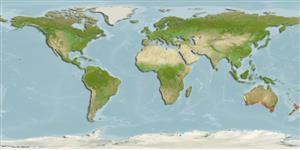Common names from other countries
Environment: milieu / climate zone / depth range / distribution range
Écologie
marin récifal; profondeur ? - 60 m (Ref. 9563). Temperate
Eastern Indian to Western Pacific: in the southern coasts of Australia.
Taille / Poids / Âge
Maturity: Lm ? range ? - ? cm
Max length : 120 cm TL mâle / non sexé; (Ref. 9563)
Épines dorsales (Total): 15 - 16; Rayons mous dorsaux (Total): 24-26; Épines anales 3; Rayons mous anaux: 9 - 10. This species is distinguished by the following set of characters: D XV-XVI, 24-26; A III, 9-10; pectoral-fin rays 14 with ventral 5 unbranched and thickened; lateral�li ne scales 45-55; height of the soft dorsal fin is roughly equal to height of the spinous portion; elongated body with shallow dorsal head profile; body cylindrical in cross section; scales cycloid and large on body; eyes moderate in size; no bone processes on frontal bones or maxilla (Ref. 120445).
Found in seagrass beds and near rocky outcrops (Ref. 9563). Feeds on polychaetes, isopods, amphipods and brown algae. Flesh of smaller fish is excellent eating, but its quality deteriorates with age (Ref. 2156).
Life cycle and mating behavior
Maturité | Reproduction | Frai | Œufs | Fécondité | Larves
May, J.L. and J.G.H. Maxwell, 1986. Trawl fish from temperate waters of Australia. CSIRO Division of Fisheries Research, Tasmania. 492 p. (Ref. 9563)
Statut dans la liste rouge de l'IUCN (Ref. 130435)
CITES (Ref. 128078)
Not Evaluated
Menace pour l'homme
Harmless
Utilisations par l'homme
Pêcheries: intérêt commercial mineur
Plus d'informations
Noms communsSynonymesMétabolismePrédateursÉcotoxicologieReproductionMaturitéFraiFéconditéŒufsDéveloppement de l'œuf
RéférencesAquacultureProfil d'aquacultureSouchesGénétiqueElectrophoresesHéritabilitéPathologiesTraitementMass conversion
CollaborateursImagesStamps, Coins Misc.SonsCiguateraVitesseType de nageSurface branchialeOtolithesCerveauxVision
Outils
Articles particuliers
Télécharger en XML
Sources Internet
Estimates based on models
Preferred temperature (Ref.
115969): 14.4 - 20.9, mean 17.5 (based on 174 cells).
Phylogenetic diversity index (Ref.
82804): PD
50 = 1.0000 [Uniqueness, from 0.5 = low to 2.0 = high].
Bayesian length-weight: a=0.00389 (0.00180 - 0.00842), b=3.12 (2.94 - 3.30), in cm Total Length, based on all LWR estimates for this body shape (Ref.
93245).
Niveau trophique (Ref.
69278): 2.9 ±0.38 se; based on food items.
Résilience (Ref.
120179): Très faible, temps minimum de doublement de population supérieur à 14 ans (Preliminary K or Fecundity.).
Fishing Vulnerability (Ref.
59153): High to very high vulnerability (72 of 100).
